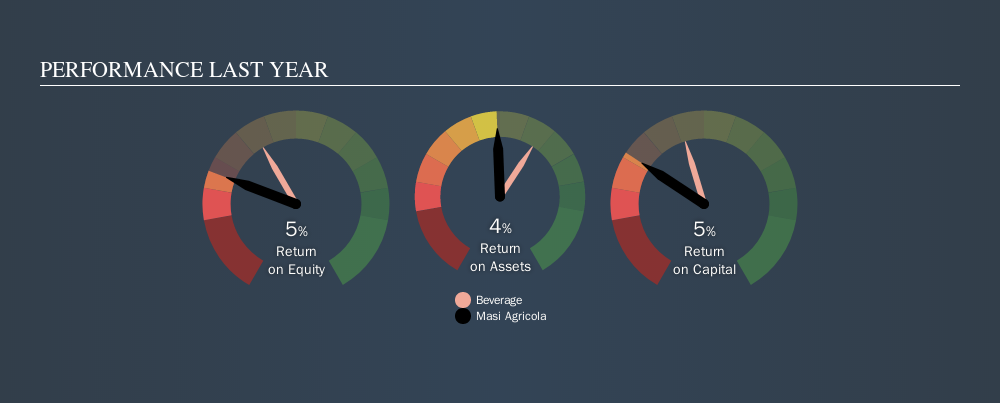Why We’re Not Impressed By Masi Agricola S.p.A.’s (BIT:MASI) 5.2% ROCE

Today we'll evaluate Masi Agricola S.p.A. (BIT:MASI) to determine whether it could have potential as an investment idea. To be precise, we'll consider its Return On Capital Employed (ROCE), as that will inform our view of the quality of the business.
First, we'll go over how we calculate ROCE. Second, we'll look at its ROCE compared to similar companies. Then we'll determine how its current liabilities are affecting its ROCE.
Return On Capital Employed (ROCE): What is it?
ROCE is a measure of a company's yearly pre-tax profit (its return), relative to the capital employed in the business. Generally speaking a higher ROCE is better. Ultimately, it is a useful but imperfect metric. Author Edwin Whiting says to be careful when comparing the ROCE of different businesses, since 'No two businesses are exactly alike.
So, How Do We Calculate ROCE?
Analysts use this formula to calculate return on capital employed:
Return on Capital Employed = Earnings Before Interest and Tax (EBIT) ÷ (Total Assets - Current Liabilities)
Or for Masi Agricola:
0.052 = €7.8m ÷ (€167m - €16m) (Based on the trailing twelve months to June 2019.)
So, Masi Agricola has an ROCE of 5.2%.
See our latest analysis for Masi Agricola
Does Masi Agricola Have A Good ROCE?
ROCE is commonly used for comparing the performance of similar businesses. In this analysis, Masi Agricola's ROCE appears meaningfully below the 9.8% average reported by the Beverage industry. This performance is not ideal, as it suggests the company may not be deploying its capital as effectively as some competitors. Regardless of how Masi Agricola stacks up against its industry, its ROCE in absolute terms is quite low (especially compared to a bank account). Readers may wish to look for more rewarding investments.
We can see that, Masi Agricola currently has an ROCE of 5.2%, less than the 10% it reported 3 years ago. So investors might consider if it has had issues recently. The image below shows how Masi Agricola's ROCE compares to its industry.

It is important to remember that ROCE shows past performance, and is not necessarily predictive. ROCE can be misleading for companies in cyclical industries, with returns looking impressive during the boom times, but very weak during the busts. ROCE is only a point-in-time measure. Future performance is what matters, and you can see analyst predictions in our free report on analyst forecasts for the company.
Do Masi Agricola's Current Liabilities Skew Its ROCE?
Short term (or current) liabilities, are things like supplier invoices, overdrafts, or tax bills that need to be paid within 12 months. Due to the way the ROCE equation works, having large bills due in the near term can make it look as though a company has less capital employed, and thus a higher ROCE than usual. To counter this, investors can check if a company has high current liabilities relative to total assets.
Masi Agricola has total assets of €167m and current liabilities of €16m. As a result, its current liabilities are equal to approximately 9.8% of its total assets. With barely any current liabilities, there is minimal impact on Masi Agricola's admittedly low ROCE.
Our Take On Masi Agricola's ROCE
Still, investors could probably find more attractive prospects with better performance out there. Of course, you might find a fantastic investment by looking at a few good candidates. So take a peek at this free list of companies with modest (or no) debt, trading on a P/E below 20.
For those who like to find winning investments this free list of growing companies with recent insider purchasing, could be just the ticket.
We aim to bring you long-term focused research analysis driven by fundamental data. Note that our analysis may not factor in the latest price-sensitive company announcements or qualitative material.
If you spot an error that warrants correction, please contact the editor at editorial-team@simplywallst.com. This article by Simply Wall St is general in nature. It does not constitute a recommendation to buy or sell any stock, and does not take account of your objectives, or your financial situation. Simply Wall St has no position in the stocks mentioned. Thank you for reading.
About BIT:MASI
Masi Agricola
Produces and distributes fine wines in Italy, rest of Europe, the Americas, and internationally.
Reasonable growth potential with mediocre balance sheet.
Similar Companies
Market Insights
Community Narratives




